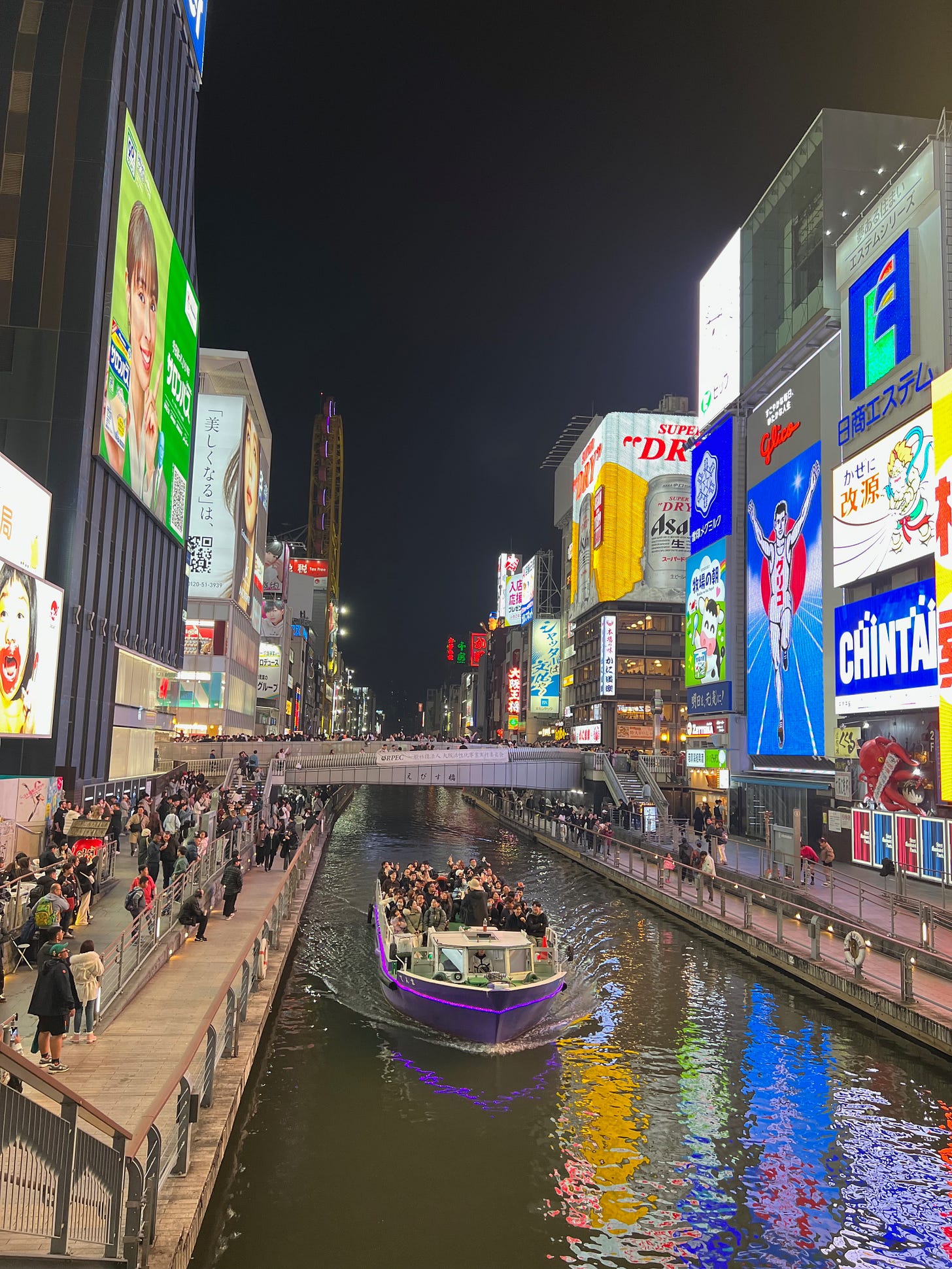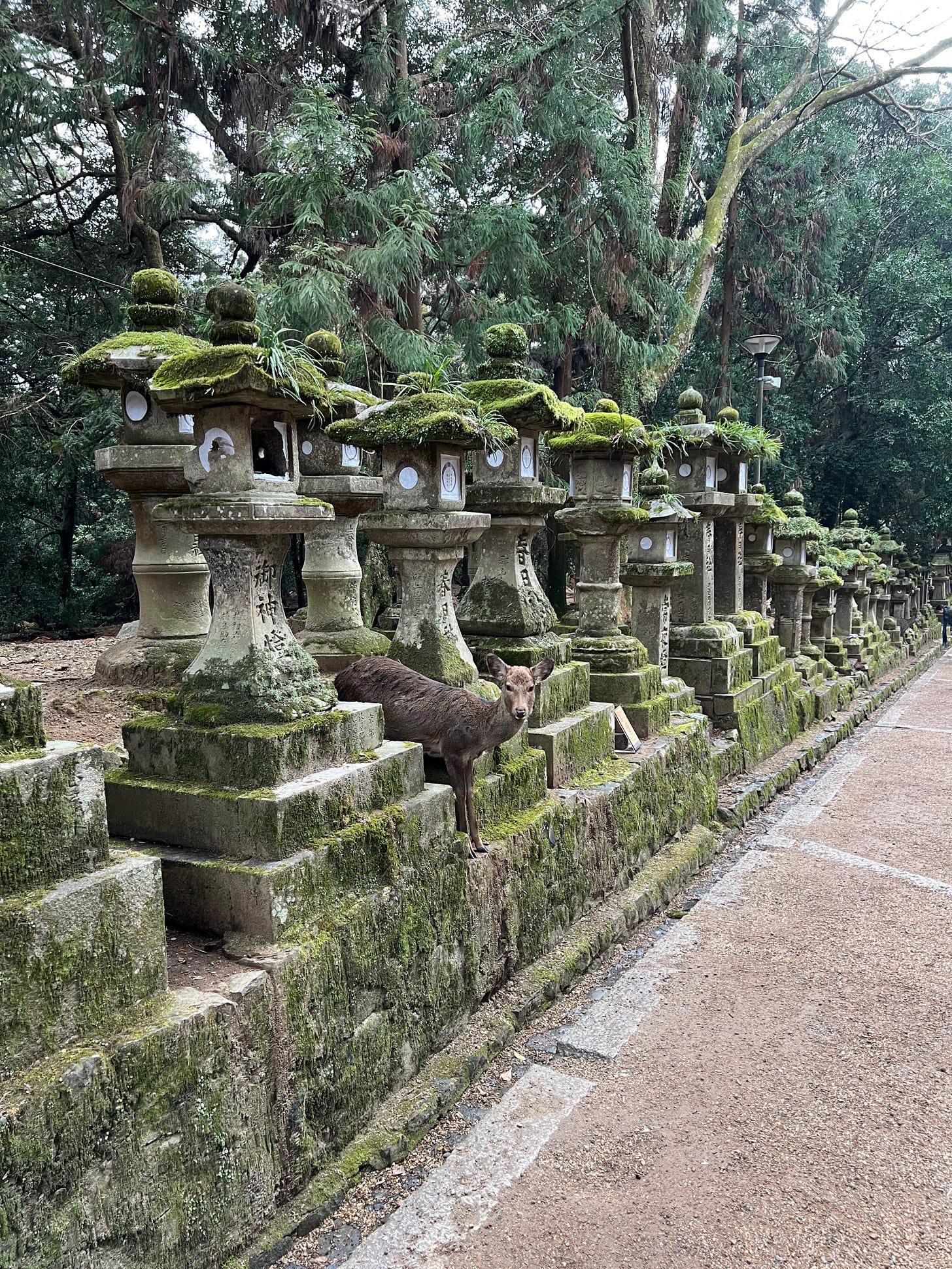This is Part III in a travel diary series about our trip through Japan. Here you can find Part I and Part II. If you’d like to receive these newsletters in your mailbox, subscribe for free! Paid subscribers will receive full access to the archives.
Other ways to support: share this newsletter with friends, leave a note in the Comment section, or click the heart button to give me an algorithm boost!
Our next stop was Osaka, commonly called the kitchen of Japan, with its own regional saying “Kuidaore,” “eat until you’re bankrupt.” Upon first impression, Osaka had a grittier feel than cosmopolitan Tokyo, which appealed to my ‘second city’ heart. Osaka was easy to get lost in. I was trying to take us to a Studio Ghibli store; Google Maps kept telling us we were standing right next to it but there was no store in sight. Finally, we realized that we were in the right spot but not the right level; the enormous underground train station included a mall filled with shops and restaurants.
After I got my Studio Ghibli fix, we hopped on the train to the Nintendo Store. The moment we crossed the store threshold, we were swept into a Gen X nostalgia fever dream. Everywhere we turned was a piece of our childhood emblazoned on a buyable piece of merchandise: Super Mario Brothers place settings and glassware, Legend of Zelda stationery and neckties, the list went on. I was a Nintendo Power subscriber for MULTIPLE years; I am the exact demographic who would spend my money on Tanooki Suit Mario washcloths.
Apparently a few hundred people felt the same, because the store was packed to the flying fish gills; I had to snake my arm through clusters of people to find a t-shirt size. By the time we pared down our shopping cart to a reasonable amount of toys for a middle-aged couple, I felt like I’d survived Coachella.
In the evening, Kurt and I walked over to Dotonbori, the popular neon-lit neighborhood packed with food stalls and nightlife on both sides of the Tombori River. From down the street, we could see a halo of light emanating over the canal, like the glow of Las Vegas when approaching from the desert. Dotonbori is a sensory overload, lit-up signs flickering like a casino, delicious smells emanating from every direction: yakitori, ramen, takoyaki, okonomiyaki. It was a Saturday night, both sides of the river swarming with people, tour boats passing by filled with poncho-clad passengers waving up at us, techno beats thumping in sync with a building-sized light show projection, and a human traffic jam where everyone stopped to take a photo of the famous Glico Man sign. Kurt and I found a table alongside the river where we snacked on okonomiyaki and Kirin Lagers and watched a group of tourists grind near a speaker blaring Cardi B and Bad Bunny (I was reminded of the line fromWalk Hard, “My customers come in here to dance erotically, and they need a clean floor to do it on!”).
One of the standout landmarks of Dotonbori is the uniquely elliptical-shaped Ebisu Tower Ferris Wheel, gracing the storefront of a six-story Don Quijote store. I usually fear Ferris wheels, but the enclosed capsule seats seemed acrophobia-friendly, so Kurt and I bought tickets to ride. Our little capsule ascended straight up for what felt like forever, until we reached the 253-foot apex and the first curves of the track were accompanied by a disconcerting grinding mechanical sound. This was way more terrifying than I anticipated, but the view of Osaka from above through the thick plexiglass window was incredible. After returning to street level, we slurped down bowls of ramen under a giant metal dragon sign across the street from a giant animated crab. How great is it, to have two feet on the ground and a belly full of noodles!
On a rainy Sunday morning, we took a day trip to Nara Park armed with a Super Mario-themed umbrella. Nara is a historic city known for its significant temples, including one that houses one of the world’s largest bronze statues of Buddha. Kurt and I were wandering separately in the Buddha statue museum when an elderly docent waved me over to his table; the next thing I knew, he handed me a pamphlet on a clipboard with a pencil, instructing me in combined Japanese and hand gestures on where to return it when I was done. It was a child’s workbook quiz about Buddha art.
“I think I’ve been assigned homework,” I whispered to Kurt when he rejoined me. The only other person I could see filling out a workbook was a nine-year-old child. But honors students be honors students 4 life, so I dutifully completed the quiz using the display signs to find the answers (which wasn’t easy since the translations didn’t always quite match). After answering all six questions, I returned the workbook to the docent, who then took out a red pen and graded my work in front of me. “One wrong!” he said, pointing, then handed me a sticker with cartoon animals on it. Why I was chosen for this task, I’ll never know—maybe I looked like I wanted a sticker (which is always correct!)
The parks and forests of Nara are home to over a thousand free-roam sika deer, and where there are deer, there are vendors selling packages of rice crackers to tourists who want to feed the animals. I’m always a fan of sanctioned animal feeding, so I bought some crackers—this, it turns out, was a mistake. I was still in the process of removing the paper wrapper when deer swarmed me, nibbling aggressively on my jacket and pants. Soon I was surrounded, frantically feeding deer as fast as my fingers allowed. When my crackers were gone, they moved on to the next victims, head-butting an Australian child to the ground just for kicks.
After escaping the deer, we visited Todaiji Temple, home to one of Japan’s largest bronze statues of Buddha. There were many other tourists filling the great hall, waiting their turn to pray at the altar or light a candle. Amidst the crowd, I missed the pillar with a hole in its base; if you are small enough to squeeze through the hole it is said that you will be granted enlightenment in your next life.
The park grounds are expansive, walkways leading to multiple historic buildings. Unable to read the signs, we wandered casually, following people and/or deer, until we happened upon a temple on a hillside overlooking Nara. I walked up the ancient stone steps, gripping the bamboo railing. Inside the temple, a service was taking place inside; we could hear monks singing and smell incense. We observed quietly from a respectful distance outside. The shoes lined up at the temple entrance settled a question I had asked Kurt earlier that day: “Do Japanese people wear Crocs?” Yes, some do!
Kurt and I followed a walking path toward Kasuga Taisha, the lantern shrine. The light rain dissipated into mist, and we found ourselves alone on the long stone steps lined by moss-covered stone lanterns. Beyond the road lay the Primeval Forest, protected land since 841 AD. The thick greenery went back deeper than my eyes could see, a natural world untouched by time. Sika deer peeked through the stone lanterns, blinking at us with their fringe of black lashes. A fawn watched us curiously, approaching on spindly legs. The deer of Nara are considered the sacred envoys of Nara, protectors of these shrines for generations. The setting was so beautiful I felt overcome by emotion. I thought again of the concept Ichigo Ichie, the unrepeatable nature of each moment, and steeped in gratitude, to experience this sacred place with my favorite person and life partner, to witness the quiet of the forest and serene deer and breathe in the scent of earth and rain.
I will mentally return to this exact place and time over and over for the rest of my life, to remember that feeling of profound peace.
When we returned to our hotel in Osaka, the rain had picked up. I bought a clear plastic umbrella at a konbini, blending into the sea of locals. Neon lights reflected off puddles in the streets. Dotonbori in the rain serves serious Blade Runner vibes. We walked through Amerika-mura, a neighborhood known for youth culture, street fashion, skateboarding, and thrift stores. It was fun to sift through piles of t-shirts in vintage stores and come across Green Bay Packer and Chicago Bulls t-shirts. After shopping, we ducked out of the rain into a conveyer belt sushi restaurant.
As our final night in Osaka waned, we merged back onto the main street, a sea of translucent umbrellas bobbing under the bright lights like jellyfish. The next morning, we’d begin our return journey to Tokyo, and that familiar tug of emotions crept back—sadness that we were nearing the end of the trip mixed with happiness for everything we’d experienced. The only solution, of course, to savor every moment while in it, steeping in it like hot tea.










❤❤❤ Makes me want to visit Japan too!
such an amazing trip, Kim!